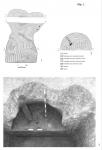Summary (English)
ARCHAEOLOGICAL EXPLORATIONS NEAR THE VILLAGE OF BOZDUGANOVO (Krasimir Nikov – k_nikov29@yahoo.com, Plamen Karailiev, Andrei Stoitsov) Thirty three sondages were carried out. Sherds from hand- and wheelmade pottery, animal bones and fragmentary plaster were found in the central part of the site, in the layer above bedrock. Archaeological structures were documented only in the central part of the site. An hour-glass-shaped pit, 1.10 m diameter of its opening, 1.50 m diameter of its bottom and 1.60 m in depth, was explored in sondage No. 16. The pit contained sherds from hand- and wheelmade pottery, fragmentary plaster, ash, charcoal and animal bones, including an antler. According to the pottery, the pit dates to the Late Iron Age (5th – 1st centuries BC). A structure dug into the ground, measuring 2.80 m by 3.10 m and 70 cm in depth, was explored in sondage No. 20. Sherds, a fragmentary pyramidal loom weight, ash, charcoal and animal bones were found in the structure. The fragmentary hearth and the postholes at the periphery of the structure testify that it was a building with light construction, probably for farming purposes. According to the pottery, the structure dates to the Late Iron Age. A pit, 0.80 – 1 m in diameter and 50 cm in depth, was explored in sondage No. 25. It contained fragmentary plaster and sherds. The pit dates to the Late Iron Age. A patch of fragmentary plaster, 3 m by 3 m in size, was partly explored to the west of the pit. The pottery dates to the Late Iron Age. A fragment of imported Greek black-gloss kylix allows the structure to be dated to the mid 5th century BC.
- Krasimir Nikov - Archaeological Institute with Museum
- Plamen Karailiev - Archaeological Museum ‘Maritsa – East’
- Andrei Stoitsov - Department of Archaeology, Sofia University St. Kliment Ohridski
Director
Team
Research Body
- Archaeological Institute with Museum
- Archaeological Museum ‘Maritsa – East’






![Download [PDF]](/excavation/skins/fasti/images/results/download_sml.png)